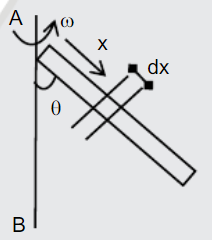The initial angular velocity of a heavy flywheel rotating on its axis is w0. Its angular velocity decreases due to friction. At the end of the first minute its angular velocity is 0.8ω0. What is its angular velocity at the end of third minute, if the frictional force is constant ?
The correct Answer is:0.4ω0 rad/min
To solve the problem step by step, we will analyze the situation using the equations of motion for rotational motion.
Step 1: Understanding the Problem
We know that the initial angular velocity of the flywheel is ω0. After the first minute (60 seconds), the angular velocity decreases to 0.8ω0. We need to find the angular velocity at the end of the third minute (180 seconds).
Step 2: Identify the Angular Deceleration
Since the frictional force is constant, the angular deceleration (denoted as α) will also be constant. We can use the following equation of motion for rotational systems:
ωf=ωi+αt
Where:
- ωf is the final angular velocity,
- ωi is the initial angular velocity,
- α is the angular acceleration (or deceleration in this case),
- t is the time.
Step 3: Apply the Equation for the First Minute
At the end of the first minute (60 seconds), we have:
ωf=0.8ω0
ωi=ω0
t=60 seconds
Substituting these values into the equation:
0.8ω0=ω0+α⋅60
Step 4: Solve for Angular Deceleration
Rearranging the equation gives:
0.8ω0−ω0=α⋅60
−0.2ω0=α⋅60
α=−0.2ω060
Step 5: Apply the Equation for the Third Minute
Now we want to find the angular velocity at the end of the third minute (180 seconds). We will use the same equation:
ωf=ωi+αt
Where:
- ωi=ω0
- t=180 seconds
- α=−0.2ω060
Substituting these values into the equation:
ωf=ω0+(−0.2ω060)⋅180
Step 6: Simplify the Expression
Calculating the term:
ωf=ω0−0.2ω0⋅18060
=ω0−0.2⋅3ω01
=ω0−0.6ω0
=0.4ω0
Final Answer
Thus, the angular velocity at the end of the third minute is:
ωf=0.4ω0
We know that the initial angular velocity of the flywheel is ω0. After the first minute (60 seconds), the angular velocity decreases to 0.8ω0. We need to find the angular velocity at the end of the third minute (180 seconds).
Since the frictional force is constant, the angular deceleration (denoted as α) will also be constant. We can use the following equation of motion for rotational systems:
- ωf is the final angular velocity,
- ωi is the initial angular velocity,
- α is the angular acceleration (or deceleration in this case),
- t is the time.
At the end of the first minute (60 seconds), we have:
ωi=ω0
t=60 seconds
Rearranging the equation gives:
−0.2ω0=α⋅60
α=−0.2ω060
Now we want to find the angular velocity at the end of the third minute (180 seconds). We will use the same equation:
- ωi=ω0
- t=180 seconds
- α=−0.2ω060
Calculating the term:
=ω0−0.2⋅3ω01
=ω0−0.6ω0
=0.4ω0
Thus, the angular velocity at the end of the third minute is:
Topper's Solved these Questions
- CIRCULAR MOTION BOOK - ICSECHAPTER - CIRCULAR MOTION EXERCISE - MODULE 2 (FROM CENTRE OF MASS)
8 Videos
- CIRCULAR MOTION BOOK - ICSECHAPTER - CIRCULAR MOTION EXERCISE - MODULE 2 (FROM MOMENT OF INERTIA, TORQUE)
22 Videos
- CIRCULAR MOTION BOOK - ICSECHAPTER - CIRCULAR MOTION EXERCISE - MODULE 2 (VERY SHORT ANSWER QUESTIONS)
14 Videos
- COMPETITION CARE UNITBOOK - ICSECHAPTER - COMPETITION CARE UNITEXERCISE - OBJECTIVE QUESTIONS FROM PREVIOUS IAS EXAMINATIONS
50 Videos
Similar Questions
Find the angular speed of the minute hand of a clock.
View SolutionWhat is the angular velocity of a particle lying on the axis of rotation ?
View SolutionWhat is the angular velocity of a particle lying on the axis of rotation ?
View SolutionAngular momentum of a rigid body rotating about a fixed Axis with angular velocity →ω
View SolutionA fly wheel is rotating about its own axis at an angular velocity 11rads−1, its angular velocity in revolution per minute is
View SolutionWhat is the direction of the angular velocity of the minute hand of a clock ?
View SolutionA wheel is rotating about its axis at a constant angular velocity. If suddenly an object sticks to it on the rim, then its M.I. will:
View SolutionA rod is rotating with angular velocity ω about axis AB. Find cosθ.

View SolutionA disc is rotating with angular velocity ω. If a child sits on it, what is conserved?
View SolutionA particle moves in a circle with constant angular velocity ω about a point P on its circumference. The angular velocity of the particle about the centre C of the circle is
View Solution
